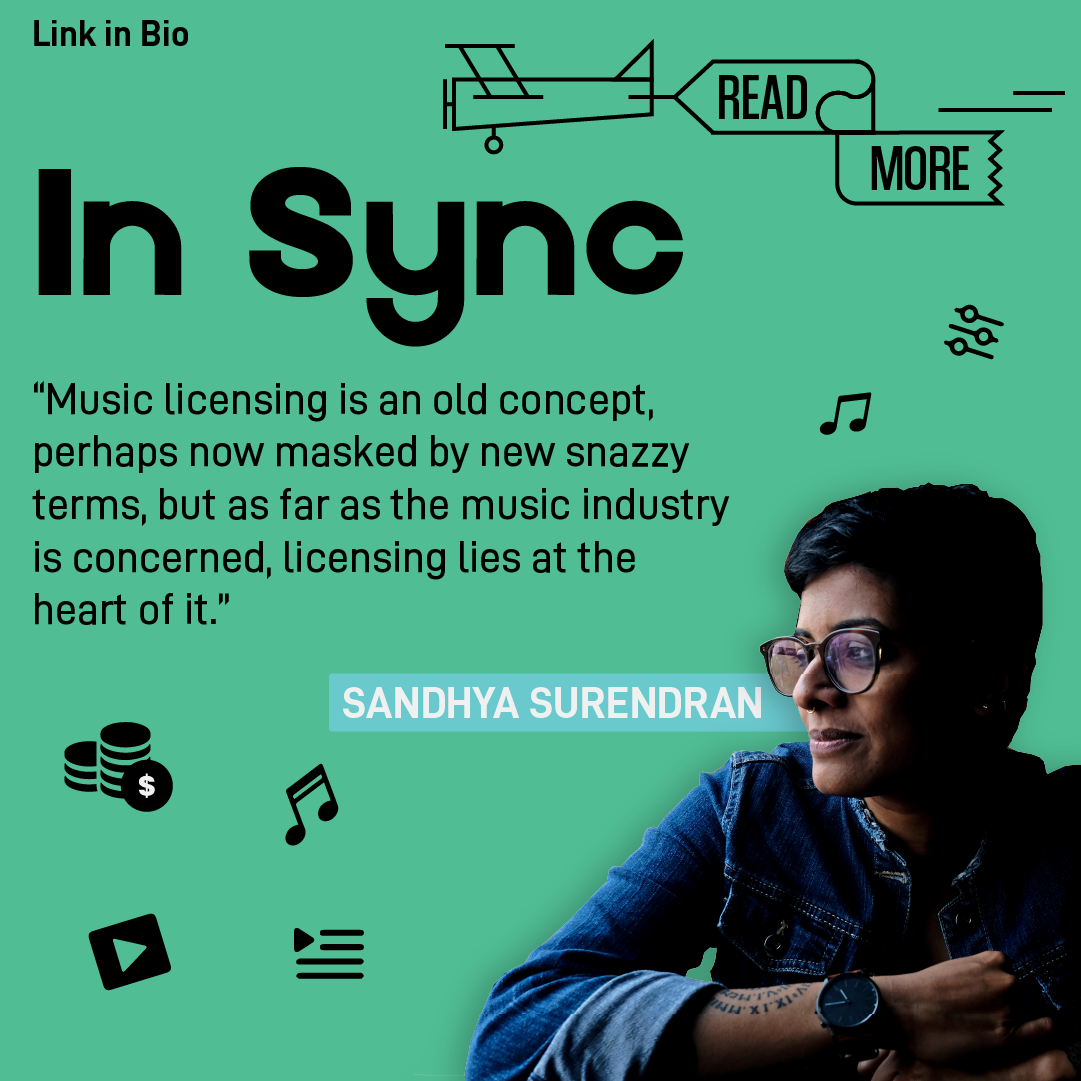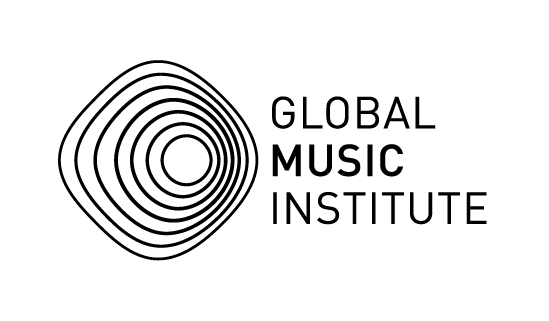
01 Nov In Sync – Sandhya Surendran
As cliche as it may sound, the internet changed the world as we know it, especially for businesses and industries. What we have traditionally known and understood about the music industry has gone through a drastic change in the last decade, and it has everything to do with how music is being distributed and consumed today. The physical space of the music industry shrank post the compact-disc era and then blew up to become the global medium it is right now. When an artist releases a song today, they are not only releasing in their respective city, but technically to the whole world. When the world is your audience, it also means your revenue streams split wide open. What does this mean for the artist or the rightsholder? This article will hopefully throw some light on that, or at least, act as a starting point for further reading.
A song has three distinctly copyrightable aspects to it: the sound recording, the composition, and the lyrics. The ownership of the sound recording is referred to as master rights and the ownership of the composition and/ or the lyrics (collectively referred to as the underlying works) is called publishing rights. If you are an independent singer-songwriter, you own all of the above, whereas if you’re an artist signed up with a record label, and/ or a publisher, these rights will be shared in such percentages as agreed to in your contract with these entities. Anyone having a stake in the copyright of a song is a “rightsholder”.
As a rightsholder, there is a bundle of rights, both exclusive and assignable, that you are bestowed under copyright law, which allow you to monetize your work. This bundle includes the right to distribute, replicate, publicly perform and/ or display, create derivative works and transmit or transfer the work. In exchange for monetary compensation, these rights can be assigned or transferred, or even just given access to. This access is the “license” to, a right to use, your work, in exchange for which you are entitled to a sum of money, i.e. a royalty fee. Royalties are then further categorized based on the kind of use of the work in question, e.g. performance royalties, mechanical royalties and sync royalties.
Tracing Roots
To better understand how royalties, a.k.a. revenue streams, work, we need to brush up a bit on what music licensing is. Music licensing is an old concept, perhaps now masked by new snazzy terms, but as far as the music industry is concerned – licensing lies at the heart of it. Licensing is intrinsically linked to publishing.
Music publishing existed even before the recording industry did, and of course, like copyright law, has its origins in Europe. We start with sheet music– a songwriter 100 years ago (give or take) would have written music in some physical form. If another musician were to play this songwriter’s music, they’d need to get permission from the songwriter. Now, this was obviously a tedious and cumbersome process. Enter-the publisher. Songwriters engaged ‘publishers’ who would (in the original sense of the word) publish the music, and for each copy made they would pay the songwriter a fee – the mechanical royalty. But it didn’t end there! If you were purchasing this sheet of music from the publisher to then go perform elsewhere, there was a separate fee for that too – the performance royalty. Over a period of time, given the volume of publishers, and with the evolution of copyright law, collective management organizations (alternatively referred to as copyright societies or performing rights organizations) were set up to represent publishers, and consequently, songwriters too. These societies collected royalties on behalf of their members and distributed the collected royalties among the members. To read more about how collective management organizations work, click here.
Fast forward to the 20th century, with the onset of technology and the birth of the recording industry, revenue streams for music also evolved. You now had a sound recording of a composition, and a separate copyright that existed in the sound recording. The broadcast industry – radio and television – led to a spike in music revenue, with film and television at the foundation of sync licensing.
The Indian Context
In the Indian context, truth be told, copyright law is still playing catch up with global standards and a lot of that has to do with how our music industry is structured. Keeping aside Indian folk and Indian classical music, which weren’t really considered part of the “industry” in conventional terms, the Indian music industry was historically seen as a subset of the Indian film industry where majority of the music that was being distributed was created specifically as soundtracks to a film. This situation, therefore, also influenced ownership, determined who held the rights to musical works, and ultimately, how these works were distributed and monetized. As a result, copyright laws in India were interpreted according to these ownership models and did not protect the creator’s long-term interests. Exploitative industry practices became the norm, where songwriters and composers assigned all rights and interest in their musical works for a fixed fee under the garb of “work for hire”.
But the 2012 amendment to the Indian Copyright Act changed the equation significantly and gave the songwriter and the performer economic rights in their original work, as opposed to only moral rights; including the right of an author to retain a minimum 50% of publishing rights. The amendment also led to the above-mentioned industry practices being challenged. With the internet disrupting conventional methods of music distribution and consumption, industry stakeholders are becoming a lot more cognizant of globally accepted fair industry practices and incorporating the same; perhaps not as quickly as one would hope for, but it is still a move in the right direction.
Given how outdated our copyright law is, India is still a long way from having standardized statutory thresholds that will ensure equitable compensation for artists, primarily due to the difficulty in implantation and execution. But it is only a matter of time before this situation is resolved – and technology is the key.
So, what is a sync license?
Sync licensing refers to the synchronization of a song with any form of visual media. Any time your song is featured in a TV show, movie, commercial, etc., that’s called a “sync placement”, where the ‘song’ includes both the sound recording and the underlying works. Therefore, safe to say, this form of licensing has been around for a long time. With the digital boom, there have been more avenues for sync licensing, even resulting in a subset of sync licensing called “micro-sync”, apart from an expansion in the scope of the sync-license in itself.
The primary difference between sync and micro-sync is scale. Sync-licensing is a one-time license issued to sync your song in a film, or web-series. Some examples of recent successful sync placements in India include Kamakshi Khanna’s* ‘Duur’ in Fame Game (Netflix) and Jugaadistaan (Amazon Prime), Easy Wanderlings’s ‘Enemy’ in Gehraiyaan, and When Chai Met Toast’s ‘Firefly’ for the teaser of Zoya Akhtar’s next film, Jee Le Zara. Each of these are one-time sync placements.
A micro-sync on the other hand is the license you grant to a platform to sync user-generated content with your music. For example, YouTube pays out royalties for micro-sync in the US.ther platforms like Instagram or TikTok also have agreements with publishers and record labels that are effectively micro-sync arrangements, paid out to these rightsholders to sync all the songs on their respective catalogues to the content generated by these platforms’ users. The catch here, however, is that as an independent artist, micro-sync opportunities are available to you depending on the distributor you work with. If you’re self-published, you could be missing out on micro-sync royalties arising from underlying works.
As mentioned above, a sync placement is a license to use all components of the song and hence the license has to be granted by all rightsholders. Typically, this license will be a single master synchronization license agreement signed by all the rightsholders and the person / entity looking at licensing the work.
Performance and mechanical royalties can be collected only via third-party agencies or copyright societies, and songwriters do not have any control on the actual amounts being collected. Typically, the amounts are as determined by law, but in the absence of such law, like in India, these amounts are determined by the applicable copyright societies. It is important to note here that these copyright societies are not government bodies, but private entities acting on behalf of a group of individuals who register to become a member of these entities.
Since sync licenses are directly issued by the rightsholders, it gives the rightsholder the advantage of limiting the scope of the licenses. Your sync deal can either be exclusive or non-exclusive, in perpetuity or limited to a certain time period, applicable worldwide or restricted to a certain country or region. It can be applicable to the entire song, or select portions. It is important to clarify here that it is possible for a sync deal to be only on the composition and/ or the lyrics, without utilizing the sound recording itself. For example, if I were to recite the lyrics of a song while rendering a voice over for a video, I would need a sync license from the rightsholder (in this case, whoever owned the publishing rights to the lyrics). Depending on where this video is going to be published, and the purpose of it, the applicable license fee would differ. This is a situation that could be a micro-sync (if I were an individual uploading an image I drew, with the voiceover of me reciting lyrics to this song) or a regular sync (if I were a voiceover artist reciting these lyrics for an advertisement of a brand, or in a film/ web series).
There is no set formula to calculating the appropriate license fees that would apply to a sync. However, there are important factors that should be taken into account when you calculate these fees: exclusivity, popularity of the song, duration of the license, where the song is going to be used. So, you’ve received a sync deal request which is an exclusive license of one of your popular songs in perpetuity for a big budget film – you can name your fee. Think about the consequences of the conditions of the license and that’ll help you with the number you want to finalize. The other important, but often overlooked aspect is who you’re licensing the track to. More often than not, an agency will be approaching you for the license in which case you need to ensure that you specify that the license you’re issuing to the agency is to be used only for the client they’ve specified, and that the license cannot be used by the agency for any other project.
Pro-tip: If you’re a music producer or composer, who is often engaged by production houses to compose songs for a film – you can structure your agreement with the production house as an exclusive sync deal, so you don’t lose rights to your music. Speak to your lawyer and have them negotiate this into your contract.
Developments
We have come a long way from collecting autographed tapes of our favourite artist, to now owning digital assets exclusively issued by that favourite artist. Yes, I’m talking about NFTs – non-fungible tokens. For the uninitiated, an NFT is a relatively simple idea (operative word being ‘relatively’): a unit of data, or a unique non-duplicatable code, that gives buyers an opportunity to own a specific digital asset verifiable through blockchain which can be purchased through several cryptocurrency platforms subject to a “smart contract”. Relatively simple, of course.
If the NFT involves audio-visual media i.e. music with video or an image/ gif, it automatically implies a sync license – assuming that the person who owns the visuals and the person who owns the music are different individuals/ entities. This is perhaps just one example of how NFTs work in music. You can purchase NFTs of individual stems of a song, or NFTs of beats, which then allow you to combine these pieces of work to create a new piece of work too. The possibilities are endless. The industry is in its nascent stages and what is now being explored is the possibility of actual ownership in music through blockchain – a much longer, more complex topic that the author will intentionally steer clear from, for now at least.
The most exciting development, specifically in the sync sector, is perhaps the numerous direct-licensing platforms that are disrupting the licensing and publishing business, by allowing songwriters to directly license “royalty-free music” to consumers – individuals and organizations – bypassing the middlemen. It acts as a one-stop shop for all music licensing requirements. Examples of these platforms include Epidemic Sound, Artlist and closer home, the newly launched Fairplay.
In Conclusion
For an artist this is an exciting time to be a part of the industry- especially with the kind of resources you have access to. Distribution is only a click-away, a far cry from having to rely on a physical distributor of cassettes or vinyl and manual records to keep track of sales. Social media, despite all its flaws, has done a pretty good job at levelling the playing field for talent – the pandemic is proof. The music industry in India definitely witnessed a significant increase in independent talent, thanks to platforms like Instagram and YouTube. Most importantly, the increase in consumption of OTT and online content has forced the industry to reconsider the way it operates and perhaps led to more structure and transparency in the way talent, like music composers & artists, are engaged. This is all alongside the fact that it has put the spotlight on the massive pool of talented musicians that operate outside the film industry, therefore resulting in an increase in demand for independent music.
All of these factors make it that much more imperative for an artist to invest in their careers and educate themselves about how copyright and licensing works. The only way the industry becomes more equitable is through increased awareness among all stakeholders.
*Kamakshi Khanna- GMI alumni
Social media links:
Instagram- https://www.instagram.com/sandhya.surendran/
LinkedIn- https://www.linkedin.com/in/sandhyasurendran/
Lex Talk Music Podcast- www.lextalkmusic.com



No Comments